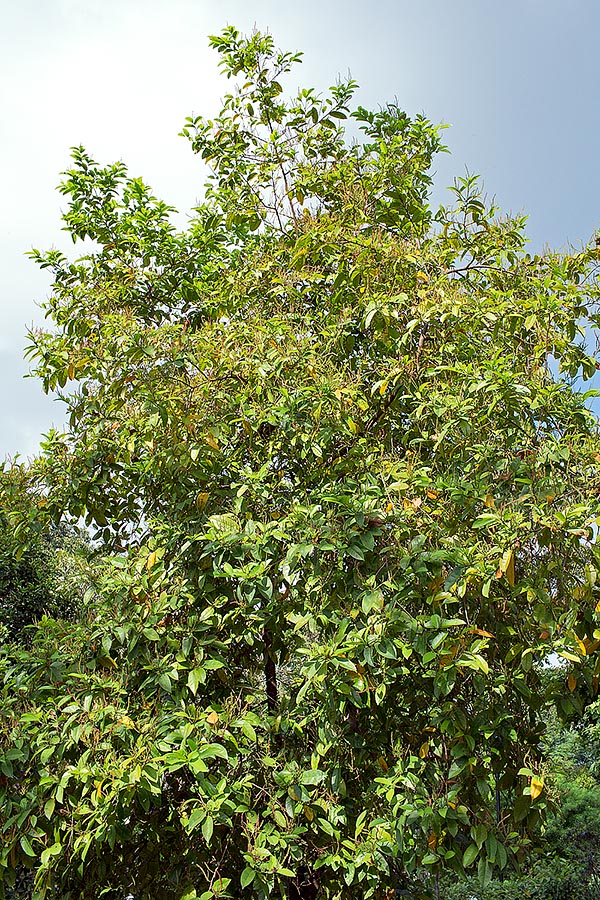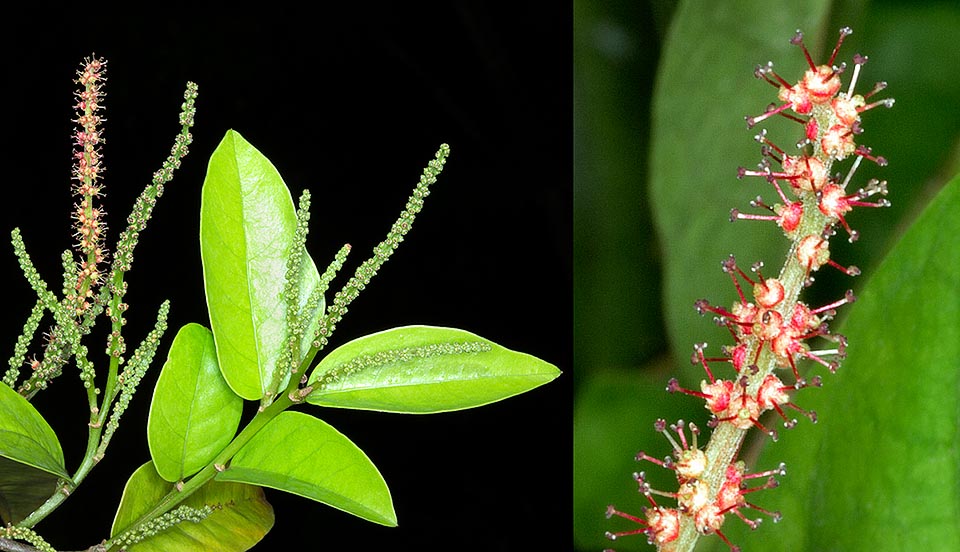Family : Phyllanthaceae

Text © Pietro Puccio

English translation by Mario Beltramini

Native to South-East Asia, Antidesma bunius reaches the height of 30 m © Giuseppe Mazza
The name of the genus is the combination of the Greek preposition “ἀντί” (anti) = against and of the substantive “δέσμα” (desma) = link, bond, bandage, after some, whilst for Joannes Burman (Burmannus) (1707-1780) it would mean poison (Thesaurus Zeylanicus), with reference to the use against the snake bite; the specific name should come, after Georg Eberhard Rumph (Rumphius) (1627-1702), from a local name (Herbarium Amboinense).
Common names: Chinese laurel, salamander-tre, wild cherry (English); wǔ yùe chā (China); buni, wuni (Java); amati, bol aborak, cerutali, janu polari, kari komme, nolaittali (India); kho lien tu (Laos); barune, berunai, buni, lundu (Malaysia); kata kuti (Moluccas); himalcheri (Nepal); bignay, bugnai (Philippines); bunih (Sulawesi); buni, huni (Sumatra); ma mao dong, ma mao luang (Thailand); choi moi tia, chòi mòi lá dày (Vietnam).
The Antidesma bunius (L.) Spreng. (1824) is a shrub or more frequently an evergreen dioecious tree that may reach the height of 30 m, often provided in the old specimens of tabular roots at the base (roots similar to buttresses), with smooth or slightly wrinkled bark of brown colour. Linear stipules (appendages at the base of the leaf that have the main task of protecting it during the initial phase of growth), about 0,5 cm long and 0,2 cm broad, caducous; leaves, on a 0,5-1,5 cm long petiole, alternate, simple from oblong-elliptic to obovate with pointed to rounded apex and entire margin, 6-20 cm long and 4-8 cm broad, of glossy dark green colour above, paler below, coriaceous.
Inflorescences bearing numerous tiny flowers, of about 2 mm of diameter, without petals, the male ones being axillar or terminal, ramified, 6-20 cm long, the female ones terminal, rarely ramified, 8-20 cm long. Sessile male flowers with 3-4 lobes calyx, rarely 5, 1-1,5 mm long, and stamina, in the same number as the lobes, 2-3 mm long, with reddish anthers; the flowers emit a quite unpleasant smell. Female flowers, on a 0,5-1,5 mm long pedicel, 2-6 mm in fruit, with calyx similar to the male one, glabrous or pubescent ovary and 3-4, rarely up to 6, stigmas; female specimens may carry also hermaphroditic flowers and fructify abundantly in absence of male plants.
The fruits are ellipsoid drupes compressed laterally, 0,8-1,2 cm long and 0,6-0,8 cm broad, glossy, initially of green colour, then white, yellow, intense red and finally blackish purple when ripe, coexisting on the same infructescence ripening in different times. The fuits contain only one oblong seed, about 7 mm long and of 5 mm of diameter, immersed in a sourish to sllightly sweet pulp when completely ripe.
It reproduces by seed, with the first blooming after 4-6 years, but usually and easily recourse is done to the vegetative reproduction in order to be sure of the sex and the variety, by cutting, grafting or air layering, with the first blooming after 2-3 years.

Close-up of the leaves and inflorescences with 2 mm tiny flowers devoid of petals. Edible fruits and confirmed medicinal virtues © Giuseppe Mazza
It is often cultivated in some of its origin areas close to the villages and in the family orchards for the fruits rich in citric acid, consumed raw or utilized in sauces to accompany the fish, for syrups and jams or for getting alcoholic beverages, whilst the young leaves are consumed, as vegetable, with rice dishes. The bark contains a toxic alkaloid; roots and leaves are utilized in the traditional medicine for the traumatisms, the fruits in the gastrointestinal disorders, indigestion, dysentery and in diabetes, in particular the hypoglycemic activity of the extracts appears to be confirmed by some laboratory studies. Finally, the bark is employed locally for fabricating robust cordages.
Synonyms: Stilago bunius L. (1767); Antidesma sylvestre Lam. (1783); Antidesma stilago Poir. (1811); Antidesma glabellum K.D.Koenig ex Benn. (1840); Antidesma retusum Zipp. ex Span. (1841); Antidesma ciliatum C.Presl (1851); Antidesma cordifolium C.Presl (1851); Antidesma floribundum Tul. (1851); Antidesma glabrum Tul. (1851); Antidesma rumphii Tul. (1851); Antidesma bunius var. cordifolium (C.Presl) Müll.Arg. (1866); Antidesma bunius var. floribundum (Tul.) Müll.Arg. (1866); Antidesma bunius var. sylvestre (Lam.) Müll.Arg. (1866); Antidesma bunius var. wallichii Müll.Arg. (1866); Sapium crassifolium Elmer (1908); Antidesma andamanicum Hook.f. (1887); Antidesma collettii Craib (1911); Antidesma crassifolium (Elmer) Merr. (1913); Antidesma thorelianum Gagnep. (1923); Antidesma bunius var. pubescens Petra Hoffm. (1999).
→ To appreciate the biodiversity within PHYLLANTHACEAE family please click here.
